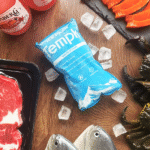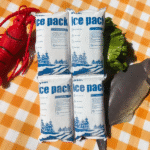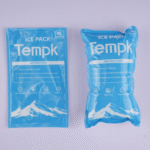If you need frozen food to arrive rock‑solid, Pacotes de gelo seco para transportar comida are still the most reliable choice. You’ll find a quick estimator, step‑by‑step pack‑outs, 2025 conformidade (Aqui está Pi 954 / DOT §173.217 / Limites do USPS), and ways to cut cost without cutting cold. This merged guide consolidates and improves your three drafts into one 2025‑ready article.
-
Quantas pacotes você precisa? Quick math using how much dry ice for 24–72 hours
-
Which packaging works best? EPS vs PUR vs VIP and Pellets vs blocos
-
Are you compliant? 2025 Aqui está Pi 954, DOT §173.217, USPS 5 lb by air
-
Como embalar? A safe, repetível ship frozen meat with dry ice workflow
-
How to save? Cut coolant and freight with right insulation & layout
Quantos Pacotes de gelo seco para transportar comida do you need?
Resposta curta: plano 5–10 lb. (2.3–4,5 kg) of dry ice per 24 horas per box, then add a 20–25% buffer for summer peaks or air transit. Low pressure at altitude and warm lanes accelerate sublimation. One pound of dry ice becomes ~250 L of CO₂ gas, so vent your packaging.
Why the range? Hold time depends on insulation (EPS < Pur < VIP), box fill %, ambient profile (por exemplo, ISTA 7D/7E summer vs winter), and whether you use blocks (perda mais lenta) or 16 mm pellets vs 3 mm pellets. VIP shippers can cut coolant mass dramatically; blocks and larger pellets last longer because of lower surface area.
Quick estimator for 24–72‑hour frozen shipments
Pick a daily loss rate based on lane & isolamento (por exemplo, 6–8 lb/day EPS, 4–6 lb/day PUR, 3–5 lb/day VIP), then add 20–25%:
| Insulation choice | Typical daily loss you plan for | Common form factor | O que isso significa para você |
|---|---|---|---|
| EPS (linha de base) | 6–8 lb/day | Foam-lined shipper | Custo mais baixo, higher dry ice payload |
| Pur (vs EPS) | ~25–40% less ice | Rigid PUR walls | Segure mais, smaller box possible |
| VIP (vs EPS) | Up to 2–3× Segure mais | Painéis VIP / reutilizável | Minimum ice, premium cost, best for long lanes |
Ranges align with published comparisons (Pur > EPS; VIP superior). Validate on your lanes with ISTA 7D/7E.*
Practical picks
-
Blocks or 16 mm pellets for line‑haul; 3 mm pellets for tight contact around product.
-
Verão & air lanes: choose a rate near the high end; altitude increases loss.
Example scenario: 48‑hour summer lane, EPS shipper. Use 7.5 lb/day + 25% → ~19 lb de gelo seco. Swap to PUR and you’ll often trim the daily rate by roughly a third—dropping total coolant by several pounds per box. (Validate with your pack‑out tests.)
Which packaging keeps Pacotes de gelo seco para transportar comida colder longer?
Tl;Dr: VIP > Pur > EPS for thermal performance; blocos > large pellets > small pellets for longevity. VIP shippers command higher prices but can slash coolant and freight (smaller outer cartons).
Detalhes: EPS is inexpensive and widely available. PUR improves R‑value and hold time over EPS. VIP panels deliver the strongest insulation; many reusable systems pair VIP with data loggers for high‑risk product. Pellet size matters: 16 mm pellets sublimate more slowly than 3 mm, enquanto blocos last the longest.
EPS vs PUR vs VIP at a glance
| Shipper type | Relative hold vs EPS | Cost tier | Your takeaway |
|---|---|---|---|
| EPS | 1× | $ | Good for 24–48 h, high ice mass |
| Pur | ~1.3–1.6× | $$ | Cut dry ice & Tamanho da caixa |
| VIP | ~2–3× | $$$ | Long lanes, minimal ice, reusable options |
Evidence from reviews and vendor specs supports the hierarchy; confirm with ISTA 7D/7E on your lanes.
Dica: Keep boxes full (less headspace), pre‑chill contents, and stage in a cold room before pickup. Those three habits often save more ice than switching pellet sizes.
São Pacotes de gelo seco para transportar comida compliant with 2025 regras?
Must‑do checklist (ar & chão):
-
Use embalagem ventilada that allows CO₂ to escape (PONTO 49 CFR §173.217(um)).
-
Mark the net dry‑ice mass (kg) no pacote externo (§173.217(c)(1)).
-
Mark/label: ““Gelo Seco" ou "Dióxido de carbono, sólido,” E 1845, Aula 9 Etiqueta de perigo (≥ 100 mm).
-
Paperwork (ar): When dry ice is the only dangerous good, no Shipper’s Declaration é necessário; incluir “UN 1845, Gelo Seco, x × y kg” no waybill ar.
-
Aqui está o PI954 acceptance requirements apply; ≤200 kg per package and proper marks/labels/weight.
-
USPS (ar): ≤5lb (2.27 kg) gelo seco por correio; more allowed by surface.
-
UPS/FedEx: Follow carrier procedures (UPS requires ISC contract for many dry‑ice lanes; FedEx provides 2025 job aids and checklists).
Segurança: Dry ice is −78.5 °C (−109.3 °F); CO₂ exposure limits: OSHA/NIOSH 5,000 ppm twa, 30,000 ppm stel. Ventilate pack‑out areas; never seal dry ice in airtight containers.
Carrier acceptance tip: IATA publishes a 2025 Dry Ice acceptance checklist—use it in QA so every box clears tender first time.
How do you pack a box with Pacotes de gelo seco para transportar comida?
De relance: bottom ice → product → top ice → void fill → vented lid → label & weigh.
-
Condição prévia product to ≤ 0 °F (-18 ° C.). Keep items tightly packed. (FDA/FSIS: keep foods ≤ 40 °F and frozen at 0 °F.)
-
Line the shipper (EPS/PUR/VIP). Adicionar dry ice blocks or 16 mm pellets to the fundo. Use corrugated pads to prevent direct contact for “chilled, not frozen” items.
-
Carregar produto in a snug layer; backfill voids with bubble or crumpled kraft (not sealed bags).
-
Top layer of dry ice. For long lanes, split ice mass 60% fundo / 40% principal so you keep a cold gradient.
-
Add a temp indicator or data logger (optional but smart).
-
Fechar & ventilação: Fazer não tape vapor‑tight; leave a small vent path per DOT/IATA.
-
Marca & rótulo: “Dry Ice” or “Carbon dioxide, sólido", E 1845, NET KG, Aula 9 rótulo. For international air waybills: ““E 1845, Gelo Seco, x × y kg.”
Hands‑on tips
-
Pistas de verão: adicionar gel packs above product to buffer brief door‑open events; keep dry ice below and above for core freeze.
-
Parcel hubs: VIP or PUR shippers reduce risk of short “danger zone” spikes (40–140 °F). Keep total time above 40 °F under 2 horas.
2025 developments & trends in Pacotes de gelo seco para transportar comida
O que há de novo 2025? More Retipadores VIP reutilizáveis, recyclable paper‑based liners (por exemplo, ClimaCell), and broader use of lane‑profile testing (ISTA 7E) and real‑time Registro de temperatura da IoT. These tools let you ship the same product with less coolant and smaller cartons—and still pass validation.
Último em um olhar
-
Carrier tooling: FedEx issued 2025 dry‑ice job aids and checklists to simplify labels and acceptance.
-
Validation shift: More teams are adopting ISTA 7E profiles for real‑world parcel temperatures; 7D still used for development stress tests.
-
Sustentabilidade: Forros recicláveis (por exemplo, ClimaCell) e reusable VIP programs are scaling with meal‑kit and grocery growth.
Insight de mercado: Cold‑chain packaging demand continues to grow in 2025; reusable systems and monitoring devices are the fastest‑rising segments as brands target waste and chargebacks. (Independent industry trackers report sustained growth through 2030.)
Perguntas frequentes
Q1: How much dry ice for shipping food do I need for 48 horas?
Plano 10–16 lb. for EPS, 8–12 lb for PUR, 6–10 lb. for VIP, Em seguida, adicione 20–25% buffer. Adjust up for hot lanes or air.
Q2: Can I ship internationally without a Shipper’s Declaration?
Sim-if dry ice is the only dangerous good. Colocar “UN 1845, Gelo Seco, x × y kg” no waybill ar; follow PI 954 and all marks/labels.
Q3: What’s the USPS limit for dry ice by air?
≤5 lb. (2.27 kg) per mailpiece by air; surface (chão) may exceed this.
Q4: Pellets or blocks—what lasts longer?
Blocos e 16 mm pellets last longer than 3 mm pellets because of lower surface area.
Resumo & Recomendações
Pontos -chave: Usar 5–10lb/dia as your planning anchor; escolher PUR/VIP to reduce ice and carton size; seguir DOT §173.217 / Aqui está o PI954 / USPS regras; e rótulo com E 1845 e Aula 9 (100 mm). Validate with ISTA 7D/7E, then trim buffer as data accumulates.
PRÓXIMOS PASSOS (fast track):
-
Run the estimator above for your lanes (24/48/72 h).
-
Pilot PUR or VIP on one hot lane to cut coolant >20%.
-
Adote o 2025 Lista de verificação de aceitação da IATA to drive first‑pass tenders.
-
Add a temp indicator/logger for QA and fewer claims.
CTA: Need a lane‑specific pack‑out? Talk to a Tempk cold‑chain specialist for a free 15‑minute optimization review.
Sobre Tempk
Tempk designs validated pack‑outs for frozen and chilled food, combining Pacotes de gelo seco para transportar comida with right‑sized EPS/PUR/VIP shippers. We back every design with ISTA thermal testing and 2025 IATA/DOT labeling guidance, helping you reduce coolant, shrink cartons, and pass carrier acceptance the first time.
Pronto para otimizar? Contact Tempk for a lane audit and pilot kit.
























